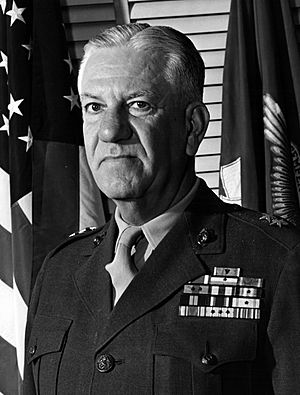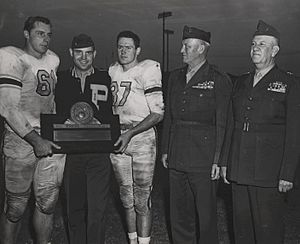Robert H. Pepper facts for kids
Quick facts for kids
Robert Houston Pepper
|
|
|---|---|

Robert H. Pepper as MG
|
|
| Born | April 22, 1895 Georgetown, Delaware |
| Died | June 1, 1968 (aged 73) Arlington County, Virginia |
| Buried | |
| Allegiance | |
| Service/ |
|
| Years of service | 1917–1957, 1961–1962 |
| Rank | |
| Service number | 0-755 |
| Commands held | Fleet Marine Force, Pacific 3rd Marine Division 1st Marine Division MCRD Parris Island Department of the Pacific 11th Marine Regiment 3rd Defense Battalion |
| Battles/wars | World War I Haitian Campaign Yangtze Patrol World War II
|
| Awards | Legion of Merit Navy Commendation Medal |
Robert Houston Pepper (born April 22, 1895 – died June 1, 1968) was a high-ranking officer in the United States Marine Corps. He became a lieutenant general. He is best known for helping to create the Marine defense battalions during World War II. Later, he led important Marine forces in the Pacific.
Contents
Robert Pepper's Early Military Journey
Robert H. Pepper was born in Georgetown, Delaware, on April 22, 1895. He went to the University of Delaware and finished his studies in June 1917. Soon after, on August 6, 1917, he became a second lieutenant in the Marines. He then went for basic training at the Marine Officers School in Quantico, Virginia.
Serving in Haiti and France
In November 1917, Pepper joined the 1st Provisional Marine Brigade. He sailed to Haiti for his first overseas mission. He served in the Caribbean until January 1920. During this time, he went on many patrols in the jungle. He was fighting against rebels called "Cacos." He was promoted to first lieutenant on July 1, 1918.
After returning to the United States, Pepper went back to Quantico. He took a special course for officers. After finishing in May 1920, he traveled to France. His job there was to help prepare maps of the World War I battlefields. He worked on this mission until December 1920, then returned to Quantico.
Learning New Skills and Moving to China
In April 1922, Pepper went back to the Caribbean. He became an aide to Brigadier General John H. Russell Jr., a high-ranking American official in Haiti. In August 1924, Pepper returned to the U.S. to attend the Army Motor Transportation School in Maryland. While there, he was promoted to captain on August 20, 1924.
After graduating in June 1925, Pepper moved to San Diego, California. He joined the 4th Marine Regiment. In February 1927, his regiment sailed to China. Pepper helped with guard duties in Shanghai International Settlement.
Developing Defense Battalions
After returning from China in July 1929, Pepper became an instructor at Quantico. In August 1931, he took command of the Marine unit on the battleship USS Oklahoma. He spent two years on patrol along the West Coast.
Pepper returned to San Diego in August 1933. Later, he moved to Parris Island, South Carolina. In July 1934, he attended the Army Coast Artillery School in Fort Monroe, Virginia. He graduated in June 1935. At the same time, he was promoted to major. He then worked in the War Plans Section at Headquarters Marine Corps.
While in this role, Pepper worked with Lieutenant Colonel Charles D. Barrett. Together, they came up with the idea for Marine defense battalions. These special units were designed to protect islands in the Pacific Ocean. They would use anti-aircraft guns and coastal defenses.
Robert Pepper in World War II
In June 1939, Lieutenant Colonel Pepper left Washington, D.C. and went back to Parris Island. He took command of the 1st Battalion, 15th Marine Regiment. This unit was renamed the 3rd Defense Battalion on October 10, 1939. Pepper was promoted to lieutenant colonel on October 1, 1939. He spent a year training his new unit. In April 1940, they sailed to Pearl Harbor. Pepper then helped prepare defenses at Midway Atoll.
Defending Pearl Harbor and Guadalcanal
In February 1941, Pepper returned to command the 3rd Defense Battalion in Hawaii. His battalion was responsible for defending the islands. During the Japanese Attack on Pearl Harbor on December 7, 1941, Pepper was at sea. He was on the heavy cruiser USS Indianapolis observing tests of a new type of boat.
Pepper was promoted to colonel in May 1942. His unit sailed to Guadalcanal in August 1942. They were there to help the 1st Marine Division. Pepper's battalion fought in the Battle of Tulagi. His unit successfully hit three enemy ships trying to land troops.
Later, he took part in the Battle for Henderson Field in October 1942. His battalion defended Lunga Point from an enemy attack from the sea. Pepper commanded the 3rd Defense Battalion until March 15, 1943. For his brave service on Guadalcanal, Pepper received the Legion of Merit with a special "Combat "V"."
Leading Artillery in New Britain
Pepper then moved to Australia to join the 11th Marine Artillery Regiment. This unit was resting after the tough fighting on Guadalcanal. He became the commanding officer on March 29, 1943. In December of that year, he led his regiment to New Britain.
During the Gloucester operation on December 26, Pepper went ashore. His regiment faced little resistance at first. However, the difficult terrain made it hard to move their artillery. The 11th Marines then provided important support fire for the Marines attacking the airfield and Aogiri Ridge.
Training New Marines
Colonel Pepper was replaced in command in January 1944. He returned to the United States the next month. After a medical leave, Pepper became the chief of staff at Camp Lejeune. This camp was a major boot camp for new Marines. Pepper helped train replacement troops for Marines fighting overseas.
He was also promoted to brigadier general at this time. Pepper stayed in this role until June 1945. For his excellent work and leadership, he received the Navy Commendation Medal.
Robert Pepper's Later Career
Pepper was sent back to the Pacific. He joined the staff of the V Amphibious Corps as the Corps Artillery Commander. He held this position until November 1945. Then, he moved to the staff of Fleet Marine Force Pacific in Hawaii. Pepper became the deputy chief of staff there.
In May 1946, he returned to the United States. He took on duties as the assistant director of personnel at Headquarters Marine Corps. In February 1948, Pepper was promoted to director of personnel. He worked in this important role for about a year and a half.
Training Recruits and Divisions
In May 1949, Pepper moved to Little Creek, Virginia. He became the commanding general of the Troop Training Unit. Here, he was in charge of training all ground forces in the Atlantic Fleet for amphibious (land and sea) operations.
In August 1950, Pepper was promoted to major general. He became the commanding general of the Marine Corps Recruit Depot Parris Island in South Carolina. He was responsible for training new recruits for about a year and a half. He then handed over command in January 1952. After that, he went to Camp Pendleton, California. He took command of the newly formed 3rd Marine Division.
The 3rd Division was brought back to active duty because of the threat during the Korean War. In August 1952, the division was sent to Okinawa, Japan. Pepper led his division in several amphibious training exercises in Japan. His unit helped defend the Far Eastern area.
Final Commands Before Retirement
In May 1954, Pepper moved to Korea. He took command of the 1st Marine Division. This unit was tasked with defending the Korean Demilitarized Zone. However, Pepper did not stay long. He was sent to Hawaii. There, he took command of the Fleet Marine Force, Pacific. This force included two-thirds of all Marine Corps combat units at the time. For this new command, he was temporarily promoted to lieutenant general.
In September 1955, he moved to San Francisco. He became the commander of the Department of the Pacific. At this time, he returned to his permanent rank of major general. He spent two years training and managing Marine units along the West Coast. He officially retired from active service on May 1, 1957, after 40 years. He was again given the rank of lieutenant general because he had been specially recognized for his combat service.
Life After the Military
Robert Pepper's retirement did not last long. In July 1960, he was called back to active duty. He joined a committee that was studying military personnel laws. In May 1961, Pepper became a senior member of a board that was reorganizing the Headquarters Marine Corps. He also joined a study group for the Department of Defense about military pay.
Robert Pepper passed away on June 1, 1968, in Arlington County, Virginia. He is buried at Arlington National Cemetery with his wife, Mildred Liebermann Pepper.
Awards and Honors
Here are the awards and honors Lieutenant General Robert H. Pepper received:
|
|
|||
| 1st Row | Legion of Merit with Combat "V" | Navy Commendation Medal | Navy Presidential Unit Citation with one star | |||||||||||||
|---|---|---|---|---|---|---|---|---|---|---|---|---|---|---|---|---|
| 2nd Row | Navy Unit Commendation | Marine Corps Expeditionary Medal with two stars | World War I Victory Medal with West Indies clasp | Haitian Campaign Medal | ||||||||||||
| 3rd Row | Yangtze Service Medal | American Defense Service Medal with Base Clasp | Asiatic-Pacific Campaign Medal with three 3/16 inch service stars | American Campaign Medal | ||||||||||||
| 4th Row | World War II Victory Medal | National Defense Service Medal with one star | Korean Service Medal | United Nations Korea Medal | ||||||||||||
| Military offices
|
||
|---|---|---|
| Preceded by Franklin A. Hart |
Commanding General of the Fleet Marine Force, Pacific August 1954 – September 1955 |
Succeeded by William O. Brice |
| Preceded by Randolph M. Pate |
Commanding General of the 1st Marine Division May 12, 1954 – July 23, 1954 |
Succeeded by Robert E. Hogaboom |
| Preceded by Merrill B. Twining |
Commanding General of the 3rd Marine Division February 15, 1952 – May 9, 1954 |
Succeeded by James P. Riseley |
| Preceded by Lester S. Hamel |
Commanding General of the MCRD Parris Island August 17, 1950 - January 29, 1952 |
Succeeded by Matthew C. Horner |




